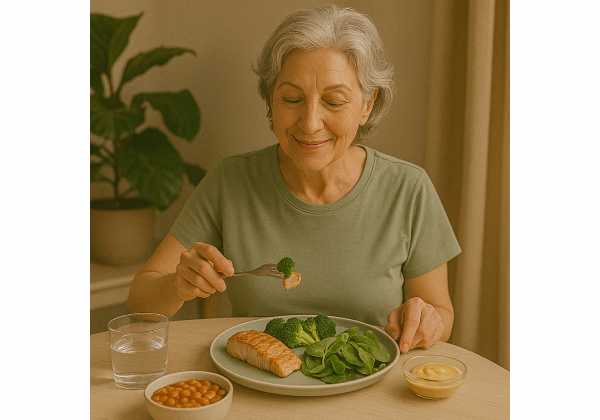
Eating well for decades doesn’t require complicated recipes or strict rules. It requires a repeatable pattern that you can use on hectic Tuesdays and relaxed Sundays alike. Constellation meals give you that pattern: build each plate from one protein, one produce (vegetables or fruit), and one healthy fat—then add smart carbs and flavor as needed. This framework steadies energy, simplifies shopping, and adapts to any cuisine. It also scales to different goals, from weight maintenance to muscle gain and smoother blood sugar. In the pages that follow, you’ll find portion guides, cuisine templates, and batch-cook shortcuts that turn the framework into a habit. For a broader foundation that pairs with this approach—covering patterns, protein, and polyphenols—see our concise guide to longevity nutrition fundamentals.
Table of Contents
- The Constellation Framework: One Protein, One Produce, One Healthy Fat
- Portion Guides and Plate Visuals for Different Body Sizes
- Build for Goals: Weight Management, Muscle Gain, and Blood Sugar Control
- Quick Examples by Cuisine: Mediterranean, Asian, Latin, and Vegetarian
- Fast Prep and Batch Cook Strategies for Busy Weeks
- How to Apply the Framework When Eating Out or Traveling
- Pantry and Freezer Staples That Make Constellation Meals Easy
The Constellation Framework: One Protein, One Produce, One Healthy Fat
A constellation meal is a simple, repeatable pattern you can build in minutes. Start with one protein, one produce, and one healthy fat—the three “stars” on your plate. Then, if desired, add a smart carb (whole grains, legumes, or potatoes), and a flavor booster (herbs, spices, acids). The structure keeps decisions light and nutrition solid.
Why this works for longevity
- Protein supports lean mass, immune function, and satiety. Hitting a meaningful amount at each meal (often 25–40 g for adults) helps counter age-related muscle loss and reduces late-day cravings.
- Produce brings fiber, potassium, and polyphenols that support vascular health, gut diversity, and steadier glucose.
- Healthy fat (olive oil, nuts, seeds, avocado, fatty fish) improves meal satisfaction, carries fat-soluble vitamins, and can enhance absorption of carotenoids from vegetables.
What counts in each category
- Protein (choose one): fish or shellfish; poultry; lean beef or pork; eggs; Greek yogurt or cottage cheese; tofu, tempeh, edamame; beans or lentils; soy or dairy protein in a smoothie.
- Produce (choose one generous portion): leafy greens; brassicas (broccoli, Brussels sprouts, cabbage); tomatoes and peppers; squash; carrots and beets; berries; citrus; stone fruit.
- Healthy fat (choose one): extra-virgin olive oil; avocado; nuts or nut butter; seeds (pumpkin, chia, flax, sesame); olives; fatty fish’s natural oils.
- Smart carb (optional): intact whole grains (farro, barley, brown rice, oats), legumes, potatoes with skin, whole-grain pasta, corn tortillas.
Five-step build
- Pick your protein first—this anchors satiety.
- Fill at least ½ plate with produce (mix cooked and raw for texture).
- Add 1–2 thumbs of healthy fat (or a palm of nuts/seeds).
- Include a smart carb if you’re active or hungry; skip or halve it when you want a lighter meal.
- Finish with acid and herbs (lemon, vinegar, fresh cilantro, basil) for brightness.
Examples in 60 seconds
- Canned salmon (protein) + tomato-cucumber salad (produce) + olive oil (healthy fat) over barley (smart carb).
- Tofu (protein) + broccoli (produce) + sesame seeds (healthy fat) tossed with soba (smart carb).
- Eggs (protein) + spinach and peppers (produce) + avocado (healthy fat) with corn tortillas (smart carb).
Constellation meals aren’t rigid. They’re scaffolding. Once you see the three stars on your plate, you’ll spot quick upgrades everywhere—from leftovers to restaurant menus and airport kiosks.
Portion Guides and Plate Visuals for Different Body Sizes
Portions should scale to the person and the plan, not to a one-size-fits-all template. Use hand-based guides and plate visuals to size meals whether you’re at home, at a buffet, or reading a menu without grams listed.
Hand-based guide (most adults)
- Protein: 1–2 palms per meal (≈25–40 g protein). A smaller adult might start with 1 palm; a larger or more active adult, 1½–2 palms.
- Produce: 2 fists (or ½–⅔ of the plate). Combine cooked and raw for volume and variety.
- Healthy fat: 1–2 thumbs of oil/nut butter or 1 small handful of nuts/seeds or ¼–½ avocado.
- Smart carb: 1 cupped hand (rest days) to 2 cupped hands (training days) of cooked grains, legumes, or starchy veg.
Plate visuals by body size and activity
- Smaller or sedentary frame (e.g., <60 kg, low activity):
- Plate: ½ produce, ¼ protein, ¼ smart carb or extra veg.
- Healthy fat: 1 thumb.
- Example: 1 palm chicken (~100–120 g cooked), 2 fists salad/veg, ½ cup quinoa.
- Average frame (60–85 kg, moderate activity):
- Plate: ½ produce, ⅓ protein, ⅙ smart carb to ¼ depending on hunger.
- Healthy fat: 1–2 thumbs.
- Example: 1–1½ palms salmon (~120–180 g), 2 fists mixed veg, ¾ cup potatoes.
- Larger or highly active frame (>85 kg, or heavy training):
- Plate: ½ produce, ⅓ protein, ⅙–¼ smart carb (often closer to ¼–⅓ on training days).
- Healthy fat: 2 thumbs.
- Example: 2 palms tofu (~180–240 g), 2 fists stir-fried veg, 1–1½ cups rice.
Breakfast, lunch, dinner rhythms
- Breakfast: keep protein and produce forward to reduce mid-afternoon cravings.
- Lunch: make it the most substantial on busy days; you’ll eat calmer at night.
- Dinner: keep portions moderate and finish 2–3 hours before sleep to protect digestion.
Adjusting in real time
- If you’re still hungry 20 minutes after eating, add protein or produce first, then a small carb bump.
- If you feel sluggish, trim the smart carb and add an extra fist of non-starchy veg.
- If you’re training later, bump carbs at the prior meal by ½–1 cupped hand.
For more granular per-meal protein targets that pair well with these visuals, skim our overview of practical daily protein ranges.
Build for Goals: Weight Management, Muscle Gain, and Blood Sugar Control
Constellation meals flex with your goals. Keep the three stars on the plate—protein, produce, healthy fat—and then dial portions, carbs, and timing.
Weight management (steady, sustainable)
- Protein at every meal: 25–35 g supports fullness and muscle retention.
- Volume from produce: 2 fists per meal; combine cooked (satisfying) and raw (crunch).
- Carb timing: favor earlier in the day when you’re more active; taper at dinner if evenings are sedentary.
- Snacks as mini-constellations: Greek yogurt + berries + walnuts; edamame + carrot sticks + tahini dip.
- Weekly rhythm: choose an 8–10 hour daytime eating window most days (e.g., 8 a.m.–6 p.m.) without making dinner late.
Muscle gain (or rebuild after time off)
- Protein pulses: 0.25–0.40 g/kg at 3–4 meals, plus a post-training meal within a few hours of lifting.
- Smart carb support: 1–2 cupped hands at meals around training; include potassium-rich carbs (potatoes, beans) for recovery.
- Healthy fats: keep 1–2 thumbs per meal; don’t slash fats so low that calories trail your needs.
- Extras: dairy, soy, lean meats, and legumes make it easier to hit totals; smoothies can bridge appetite gaps.
Blood sugar control (smoother curves)
- Order of eating: vegetables → protein/fat → starches last. Many people see gentler post-meal glucose with this sequence.
- Carb quality and quantity: favor legumes, intact grains, and potatoes with skin; start with 1 cupped hand of starch and adjust.
- Acid and fiber: use vinegar or citrus dressings, and include 8–12 g fiber earlier in the day.
- Movement: a 10-minute walk after meals improves glucose uptake.
- Breakfast matters: a protein-rich, modest-carb breakfast often reduces afternoon cravings and nighttime snacking.
An example day (average adult, office job + evening walk)
- Breakfast: eggs (protein) + sautéed spinach and peppers (produce) + avocado (healthy fat) + one slice whole-grain toast (smart carb).
- Lunch: lentil-salmon bowl (protein combo) + roasted carrots and broccoli (produce) + olive oil vinaigrette (healthy fat) + ¾ cup farro (smart carb).
- Dinner: tofu and green beans (protein + produce) stir-fried in sesame oil (healthy fat) over cauliflower rice; small side of brown rice if still hungry.
For additional strategies that specifically flatten spikes while preserving enjoyment, see our practices for smoother post-meal glucose.
Quick Examples by Cuisine: Mediterranean, Asian, Latin, and Vegetarian
Constellation meals fit any food culture. Use these templates to assemble plates you actually want to eat—fast.
Mediterranean
- Protein: grilled fish, sardines, chicken souvlaki, chickpeas, or lentils.
- Produce: tomato-cucumber salad, roasted eggplant, greens sautéed with garlic, citrus segments.
- Healthy fat: extra-virgin olive oil, olives, tahini, nuts.
- Smart carb: farro, bulgur, whole-grain pita, potatoes with skin.
- Example: grilled sardines (protein) over greens and tomatoes (produce) with olive oil and lemon (healthy fat), plus a small side of bulgur (smart carb).
East and Southeast Asian–inspired
- Protein: tofu/tempeh, edamame, eggs, salmon, shrimp, chicken, lean beef.
- Produce: bok choy, broccoli, napa cabbage, peppers, mushrooms, snow peas, kimchi.
- Healthy fat: sesame seeds, avocado, peanut sauce, canola/peanut oil (small amounts).
- Smart carb: brown rice, soba, black rice, beansprout-heavy noodles.
- Example: tofu (protein) stir-fried with broccoli and peppers (produce) in a teaspoon of sesame oil topped with sesame seeds (healthy fat), served with ¾ cup brown rice (smart carb).
Latin American–inspired
- Protein: beans, black-eyed peas, fish, chicken, lean pork, eggs.
- Produce: pico de gallo, avocado-tomato salads, plantains (count as carb), peppers, cabbage slaw, citrus.
- Healthy fat: avocado, pumpkin seeds, olive oil.
- Smart carb: corn tortillas, beans, sweet potato, hominy.
- Example: chicken tinga (protein) wrapped in corn tortillas (smart carb) with cabbage-lime slaw and salsa (produce) and sliced avocado (healthy fat).
Vegetarian
- Protein: tempeh, tofu, seitan, eggs, Greek yogurt, cottage cheese, soy milk, lupini beans.
- Produce: all colors—aim for 2 fists per meal.
- Healthy fat: olive oil, nuts, tahini, avocado, seeds.
- Smart carb: lentils, chickpea pasta, quinoa, potatoes.
- Example: tempeh (protein) tossed with roasted Brussels sprouts and carrots (produce) with tahini-lemon sauce (healthy fat) over quinoa (smart carb).
Flavor boosters that travel across cuisines
- Acids: lemon, lime, rice vinegar, balsamic.
- Herbs: basil, cilantro, parsley, mint, dill.
- Spices: cumin, smoked paprika, za’atar, turmeric-ginger, five-spice.
- Crunch: toasted nuts or seeds.
- Heat: chili flakes, gochujang, harissa.
If you’re leaning into a Mediterranean pattern overall, these templates pair well with our starter guide to Mediterranean eating.
Fast Prep and Batch Cook Strategies for Busy Weeks
When life is full, you don’t need more recipes—you need building blocks. A two-hour prep block can produce 10–14 meals’ worth of components you mix and match in minutes.
Batch-cook proteins (choose 2–3)
- Oven: sheet-pan chicken thighs; salmon fillets; tofu slabs brushed with soy-ginger.
- Stovetop: lentils (green or black hold shape); ground turkey/tempeh crumbles; bean pot with aromatics.
- Pressure cooker/slow cooker: shredded chicken; chuck roast; bean-and-veg chili.
Batch-prep produce
- Roast trays of broccoli, carrots, Brussels sprouts, and peppers.
- Wash and spin salad greens; store with a paper towel.
- Chop “aromatic mix” (onion, celery, carrot) for fast soups and sautés.
- Freeze fruit in single-serve bags for smoothies.
Cook 2 smart carbs
- A pot of whole grain (farro, brown rice, barley) and a tray of roasted potatoes or sweet potatoes.
- Cool grains on a sheet pan before refrigerating (better texture, less clumping).
Make two sauces
- Creamy: tahini-lemon-garlic or yogurt-herb.
- Bright: chimichurri, salsa verde, or citrus-olive oil vinaigrette.
Assemble in 10 minutes
- Bowl: grain + protein + 2 veg + sauce + seeds.
- Salad: greens + protein + roast veg + olives/nuts + vinaigrette.
- Taco/wrap: protein + slaw + salsa + avocado on corn tortillas or whole-grain wraps.
- Soup-stretch: add roast veg and pre-cooked protein to a boxed low-sodium broth; finish with lemon.
Storage and safety
- Cool foods quickly; store in shallow containers; label with date.
- Most cooked proteins and grains keep 3–4 days refrigerated; freeze portions you won’t eat by then.
- Keep ready-to-eat items (greens, herbs, sauces) at eye level to make the choice easy.
For a deeper dive into setting up a low-stress prep routine that repeats every week, check our playbook for batch cooking and freezer staples.
How to Apply the Framework When Eating Out or Traveling
Menus and airports can feel chaotic. The constellation lens turns them into simple choices: spot the protein, locate the produce, choose the healthy fat, and right-size the smart carb.
At restaurants
- Scan for protein first: grilled fish, rotisserie chicken, lean steak, tofu/tempeh, bean-based mains.
- Double produce: ask for extra vegetables or a side salad; replace fries with veg or beans.
- Choose the fat: request olive oil for dressing; add avocado, olives, or nuts if the dish is lean.
- Carb calibration: enjoy the starch that comes with the dish, but cap portions (e.g., half the rice) unless you trained that day.
- Sauce savvy: order sauces on the side; use enough for enjoyment, not as the main calorie source.
At fast-casual spots
- Bowl assembly: pick protein, 2 veg, a legume or whole grain, healthy fat topping, and a bright dressing.
- Sandwich shops: choose whole-grain bread; fill with lean protein and extra veg; add a small side of nuts or fruit.
- Pizza night: add a protein (chicken, tofu, beans) and extra veg; pair 1–2 slices with a big salad dressed in olive oil.
In airports and on the road
- Quick constellation: Greek yogurt or cottage cheese (protein) + fruit cup (produce) + nuts (healthy fat).
- Packables: tuna packets, jerky, roasted chickpeas, nuts, apples, baby carrots, whole-grain crackers.
- Coffee shop: protein box, oatmeal topped with nuts and fruit, egg-based breakfast sandwich (skip extra cheese and sauces, add fruit).
- Timing: if you land late, make the meal light and protein-forward with produce; keep starches small to protect sleep.
Hotels
- Mini-fridge kit: yogurt, pre-washed salad mix, cherry tomatoes, hummus, olives, smoked salmon or tofu, whole-grain wraps.
- Breakfast buffet: eggs or yogurt (protein), fruit/veg, nuts/seeds; add a small smart carb if you’ll be active.
For portable foods and tactics tailored to airports, trains, and long drives, browse our checklist of travel-friendly choices.
Pantry and Freezer Staples That Make Constellation Meals Easy
A well-stocked pantry turns “nothing to eat” into dinner in under ten minutes. Build yours around the three stars—protein, produce, healthy fat—plus smart carbs and flavor.
Protein (shelf or freezer)
- Canned tuna, salmon, sardines (in water or olive oil).
- Canned beans and lentils; dry lentils (cook fast).
- Firm tofu and tempeh (fridge/freezer); edamame (freezer).
- Frozen fish fillets and shrimp; rotisserie chicken (next-day freezer portions).
- Greek yogurt, cottage cheese; shelf-stable milk or soy milk.
- Eggs; small stash of protein powder for “emergency breakfasts.”
Produce (long-keepers + frozen)
- Onions, garlic, carrots, cabbage, beets, winter squash (long storage).
- Potatoes and sweet potatoes (cool, dark spot).
- Frozen broccoli, spinach, peas, mixed veg, and riced cauliflower.
- Jarred roasted peppers, sundried tomatoes, artichokes (rinse oil-packed items if desired).
- Shelf-stable fruit: apples, citrus; frozen berries and mango.
Healthy fats
- Extra-virgin olive oil; avocado oil (high-heat cooking).
- Nuts (almonds, walnuts, pistachios), seeds (pumpkin, chia, flax, sesame).
- Olives, tahini, nut butters.
- Avocados (buy at different ripeness stages).
Smart carbs
- Farro, barley, quinoa, brown rice, oats.
- Whole-grain pasta and corn tortillas.
- Canned chickpeas, kidney beans, black beans.
- Whole-grain breads (freeze slices).
Flavor boosters
- Vinegars (balsamic, red wine, rice).
- Citrus (lemons, limes).
- Spices: cumin, smoked paprika, turmeric, chili flakes, curry powder.
- Salsa, harissa, gochujang, mustard, low-sugar ketchup.
- Low-sodium broth or stock concentrates.
Five “nothing in the house” meals
- Tuna-bean salad: tuna + white beans + jarred peppers + olive oil + lemon + herbs.
- Egg-veg skillet: eggs over a bag of frozen mixed veg; finish with olive oil and chili flakes; toast on the side.
- Chickpea pasta bowl: whole-grain or legume pasta + frozen spinach + olive oil + sundried tomatoes + walnuts.
- Tofu stir-fry: tofu + frozen broccoli + soy-ginger splash + sesame seeds over quick-cooked rice.
- Soup stretch: boxed broth + canned beans + frozen veg + farro; finish with olive oil and lemon.
Restock rhythm
- Keep a running list on the fridge or phone; restock staples before you run out.
- Rotate canned fish and beans by placing new items behind older ones.
- Pre-portion nuts and seeds to prevent mindless handfuls.
A pantry built on these staples makes the constellation pattern automatic: grab a protein, add a produce, finish with a healthy fat—done.
References
- Dietary Guidelines for Americans, 2020–2025 (2020) (Guideline)
- Dietary Protein Intake and Human Health (2020) (Review)
- Effect of Protein Distribution Across the Day on Muscle-Related Outcomes (2022) (Systematic Review)
- Postprandial Glycemia: Nutritional Strategies for Glucose Control (2021) (Review)
Disclaimer
This article is educational and does not replace personalized medical advice, diagnosis, or treatment. Nutrition needs vary by health status, medications, and goals. If you have diabetes, kidney disease, cardiovascular conditions, or digestive disorders, discuss meal changes—including protein targets and fiber increases—with a qualified clinician or registered dietitian.
If this guide helped you, please consider sharing it on Facebook, X (formerly Twitter), or a platform you prefer, and follow us for future updates. Your support helps us continue producing practical, evidence-based content.










